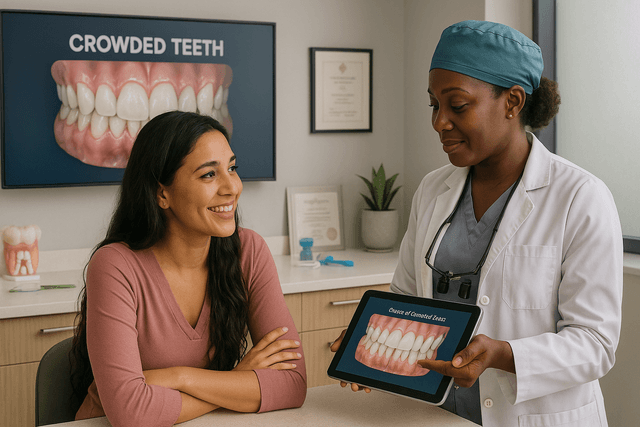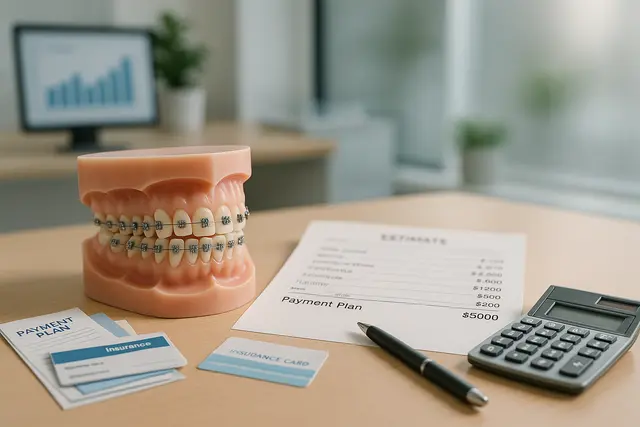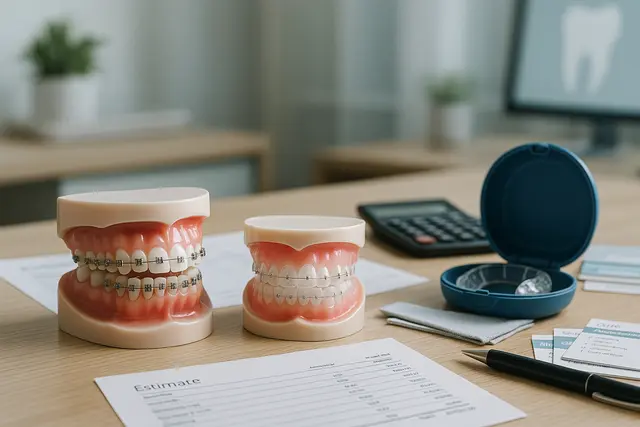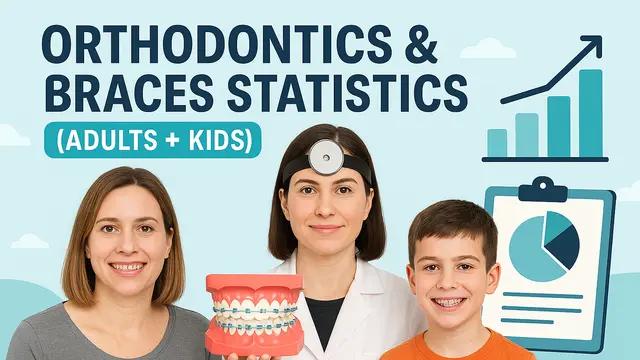Orthodontics
5 min read
Jul 22, 2025
What Causes Crowding in Teeth? Genetics, Habits, and More
Crowded teeth aren’t just a cosmetic issue, they can affect your oral health, comfort, and confidence. Whether it’s a slight overlap or a full-on dental traffic jam, understanding what causes teeth to crowd is the first step toward getting your smile back in line.

You wake up, look in the mirror, and notice your teeth aren’t quite lining up like they used to. Maybe your front teeth are starting to overlap, or your lower teeth are twisting just a bit. It’s more common than you think, and you’re not alone. A crowd can be great at concerts, but in your mouth? Not so much. Let’s explore what causes crowded teeth, how it happens, and what you can do to fix it before your teeth throw a full-blown traffic jam.
The Usual Suspects That Cause Crowded Teeth
When it comes to dental crowding, the culprits range from family genes to quirky habits you may not even realize are affecting your bite.
First up: genetics. If your parents or grandparents had misaligned teeth, there's a decent chance you’ll inherit their smile situation. A small jaw from one side of the family mixed with large teeth from the other can create the perfect storm for crowding. It's like trying to park a school bus in a compact car spot, there’s just not enough space in the mouth for permanent teeth to grow comfortably.
Next, baby teeth. They’re adorable, yes, but when they stick around too long or fall out too early, they can cause the adult teeth to erupt in all the wrong places. And if those baby teeth don’t make way for permanent teeth on time, you’re left with twisted teeth and a mouthful of chaos.
Other common causes include thumb sucking, tongue thrusting, or using a pacifier beyond the baby stage. These habits can push teeth out of alignment and encourage teeth to become misaligned over time.
Types of Teeth Crowding and How to Spot Them
Teeth crowding can range from barely noticeable to “how do I even floss between these?”
Mild crowding: This often means just one or two teeth are slightly out of place.
Moderate crowding: More teeth are affected, and overlap becomes more visible.
Severe crowding: Now we’re talking twisted, overlapping teeth with hardly any room to breathe.
Each type brings its own challenges, from cosmetic concerns to real-deal oral health issues like difficulty brushing and flossing, jaw pain, and even gum disease.
Dental Crowding Is More Than Just a Cosmetic Issue
Sure, overcrowded teeth can mess with your selfie game, but the real problem goes deeper. When your teeth don’t line up right, it can lead to uneven teeth wear, jaw strain, and even tooth decay from food and plaque hiding in tight spots. You might also experience malocclusion, which is a fancy word for a misaligned bite, and trust us, your jaw won't thank you for it.
Crowded teeth can cause hygiene headaches, too. It’s harder to brush and floss when your teeth overlap like a game of Tetris. That can lead to a cavity or two, bad breath, and even more dental visits than you bargained for.
Causes of Teeth Crowding You Didn’t See Coming
While genetics and habits are major players, there are some sneakier causes of teeth crowding that might surprise you.
Missing teeth: When one or more teeth don’t show up for the party, the others shift around to fill the gaps.
Extra teeth: Too many guests in the dental arch? That’ll definitely overcrowd the space.
Wisdom teeth: These late bloomers often erupt with a pushy attitude, forcing your other teeth to squeeze tighter together.
Small jaws and large teeth: If the teeth-to-fit ratio is off, the results are never pretty.
In kids, a crowded mouth can make it harder for adult teeth to erupt properly. And if permanent teeth start growing before baby teeth are out of the way, well, now you’ve got teeth playing musical chairs with no rules.
Options for Crowded Teeth That Actually Work
Wondering how to treat crowded teeth without turning your life upside down? Good news, there are several treatment options available.
For starters, your orthodontist might suggest clear aligners like Invisalign. These invisible trays gradually move your teeth into place without metal wires or brackets. They're great for mild to moderate crowding and especially popular with adults.
Traditional braces are another solid choice, especially for more severe cases. They offer control and precision that can tackle even the toughest twists and overlaps.
In some situations, especially when there's just not enough space in the mouth, your orthodontist may recommend tooth extraction before starting treatment. Sounds intense, but it can make all the difference in aligning your bite and improving your oral health.
In some cosmetic cases, dental veneers can create the appearance of a straighter smile.
Brace Yourself: How Orthodontic Treatment Helps
Braces might not be everyone’s favorite accessory, but they’re incredibly effective for correcting dental crowding. Whether you're dealing with crooked teeth in front or overcrowded teeth along the sides, braces can realign everything over time. You may need to wear a retainer afterward to keep your smile in place and prevent those sneaky teeth from shifting back.
Orthodontic treatment works best with a personalized treatment plan. Your orthodontist will look at the severity of the crowding, the shape of your dental arch, and how your top and bottom teeth come together before deciding on the best treatment options for your specific case.
The Role of Your Orthodontist in All This
Think of your orthodontist as your smile coach. They’re the ones who map out your treatment plan, choose the right method (brace, aligners, or other tools), and make sure everything’s moving in the right direction.
They’re also the ones you’ll thank when your jaw feels better, your bite works right, and your teeth no longer play bumper cars every time you chew.
Fix Crowded Teeth With These Treatment Options
If you're ready to fix crowded teeth and reclaim your smile, here’s a quick breakdown of the best treatment options:
Clear aligners: Low-key and removable, ideal for mild to moderate crowding.
Braces: Time-tested and great for moderate to severe crowding.
Retainers: Used after orthodontic treatment to hold everything in place.
Dental veneers: In some cosmetic cases, veneers can create the appearance of a straighter smile.
Tooth extraction: When space is too tight, removing a tooth may be necessary to allow others to fall in line.
Every mouth is different, so working with a skilled orthodontist is key to finding what works best for you.
Don’t Let a Crowd Take Over Your Smile
Dental crowding might seem like just a cosmetic nuisance, but it can affect more than your confidence. From overlapping teeth to jaw problems and hygiene struggles, teeth crowding can sneak into every corner of your daily routine.
The good news? You have options. Whether you’re dealing with crowded teeth in children or your own adult teeth are doing the cha-cha, a solid treatment plan from your orthodontist can make all the difference.
And remember, teeth can cause problems, but with the right support, they can also sparkle like champs.
Let your smile breathe. There’s no need for a crowd in there.
What Are the Most Common Causes of Crowded Teeth?
Crowded teeth often result from a mix of genetics, childhood habits, and growth patterns. If you inherit a small jaw from one parent and large teeth from another, there may not be enough space for teeth to align properly. Habits like thumb sucking, prolonged pacifier use, and early or late loss of baby teeth can also shift the way adult teeth grow in.
Is Dental Crowding Just a Cosmetic Issue?
No, crowded teeth go beyond aesthetics. Overlapping teeth can trap food and plaque, leading to tooth decay and gum disease. They also make brushing and flossing harder, and in some cases, crowding can cause bite misalignment, jaw discomfort, and uneven wear on your teeth.
What Treatment Options Are Available for Crowded Teeth?
Treatment depends on the severity of the crowding. Clear aligners like Invisalign work well for mild to moderate cases. Traditional braces are best for more severe misalignment. In some cases, dentists may recommend tooth extraction or cosmetic solutions like veneers. A personalized plan from your orthodontist ensures the most effective results.
Can Teeth Crowding Be Prevented?
While you can’t prevent genetic causes, early dental visits can catch issues before they worsen. For kids, stopping thumb sucking early and monitoring the timing of baby tooth loss can help. Regular dental checkups also allow your dentist to intervene if crowding starts to develop.
Read Next
Related Posts

Orthodontics
How Much Are Metal Braces? Cost Comparison With Other Options
Thinking about getting braces but overwhelmed by the cost? You’re not alone. Orthodontic treatment can be a major investment, and understanding the different price points, from metal braces to clear aligners, can help you make a smart, confident decision.
5 min read
Sep 15, 2025

Orthodontics
Retainer That Looks like Braces: Benefits for Long-Term Alignment
A retainer might not get as much attention as braces, but it plays a crucial role in maintaining your smile after orthodontic treatment. Whether you're new to retainers or curious about the type that looks like braces, understanding their purpose and benefits is key to keeping your teeth aligned for the long haul.
6 min read
Sep 15, 2025

Orthodontics
Orthodontics & Braces Statistics (Adults + Kids)
Orthodontics has transformed from a niche medical service for teenagers into a booming sector that spans all ages. Today, both adults and children seek orthodontic treatment to improve their smiles, fix bite issues, and boost self-confidence.
4 min read
Aug 21, 2025
Don’t have time to research every dentist around you?
See why 30k+ patients trusted us